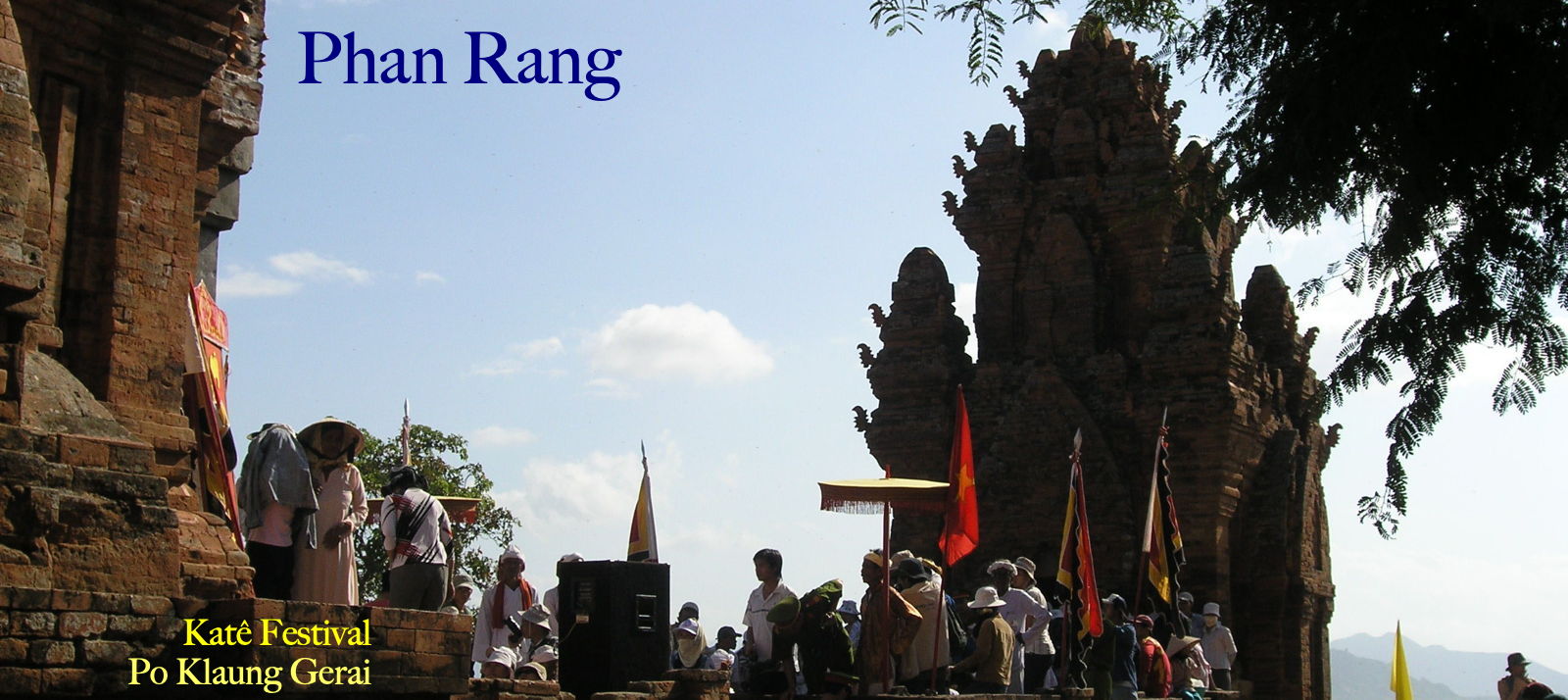PHAN RANG & PANDURANGA
The city of Phan Rang, in Ninh Thuận province, takes its name from Panduranga, the southernmost Cham polity along the coast. The realm of Panduranga, which also encompassed Bình Thuận province to the south, is strikingly different than the other regions of Champa. Called “the Iron Coast” by the French, it is the driest province in Vietnam. You’ll see rice fields here, but also goats, and somewhere there is tobacco, and grapevines.
Of course, my attention is always drawn to the Cham temples, and Ninh Thuận has two that are still used for worship by the Cham communities: Po Klaung Gerai and Po Ro Me. Thanks to the ongoing attentions of the Cham, these have been well-maintained over the centuries and, along with Po Nagar in Nha Trang, give us the most complete impression of the glories of Champa.
Attending the Kate Festival, 2006
Having read most of what there was to read about Champa (at least at that time), I decided to travel to Phan Rang in the fall of 2006 during the period of Kate, the best-known of the Cham ceremonial observances. I contacted a couple of people I knew to see if they were likely to be attending.
My friend in the government sector warned that we would have to get permission from the provincial authorities to attend. I sensed nothing but trouble in that direction—having worked for a long time in a major bureaucracy, I knew that any such request would send the responding office into a tizzy of internal deliberations and activate all of the defense mechanisms for which bureaucrats have become famous. I couldn’t see any problem going as a humble tourist—it is, after all, touted as a public event—and so I let that particular conversation drop.
On the other hand, an anthropologist with whom I had corresponded in the past was intrigued. Although she was now working elsewhere, she thought this was a capital idea, and began making her own plans to attend. Thus convinced that I was not off my rocker, I laid out a three-week itinerary that would take me through the Hanoi, the north, and conclude in Phan Rang.
I arrived the day before the first event, which is the ceremonial transfer of the ritual paraphernalia from the Raglai tribe, which keeps them in the mountains. The origins of this custom are obscure, but it speaks to the long-standing relationships between the Cham on the coastal lowlands and highland minority groups. The safeguarding of sacred garments might have something to do with the intermittent conflicts between the Cham and the Vietnamese from 1600 to the 1830s, but it might have an even older history. The Cham were always vulnerable to attacks from the sea, the most serious being an attack by Kublai Khan’s forces in 1282 that forced Indravarman V to abandon Vijaya and take to the neighboring hills for two years.
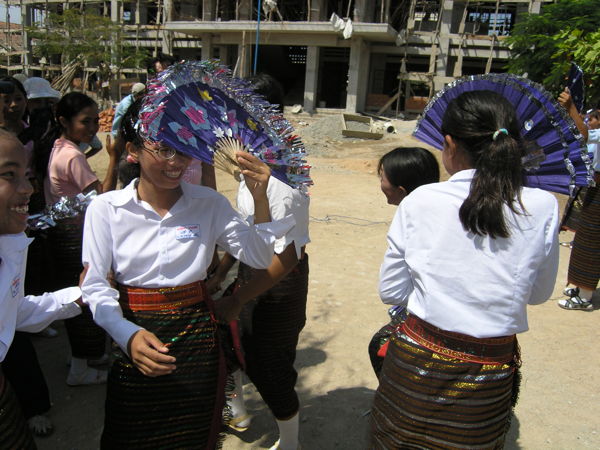
Dancers at Hữu Đức village
All that I knew for sure was that the Raglai emissaries would be coming to the village of Hữu Đức (Palei Hamu Tanran) in the early afternoon. Not much was going on when I arrived at noon, so I wandered out into the rice fields to take some pictures. A quartet of water buffaloes spotted me and charged in my direction, building up a furious momentum. I was a bit alarmed, but the thought occurred to me that they had mistaken me for whoever was supposed to herd them. Even as the image of Cretan acrobats doing springing handstands over the backs of bulls flashed through my mind, I reminded myself that seven-year old boys bossed these half-ton beasts around without giving a moment’s thought to their horns and their substantial mass. Standing on the dike gave me a height advantage, and raising myself up on tiptoe, I made myself as large as possible. As I bellowed at them, they suddenly pulled up, clearly puzzled by my unexpected behavior.
Crisis averted, I continued with my attempts to capture some reasonable likeness of the luminescent green of a tropical rice field. For some reason, I thought it necessary to step into the field itself, and went knee-deep into the mud. One of my sandals was sucked right off my foot (reminder: you’re supposed to take your footwear off before you step off the dike!) and I hobbled back to the village like My Son John.
The festival banners were stretched across the main street, but no one seemed to know what was supposed to happen, or when. Or where. Then there was a sudden alarum as a procession of white-clad marchers turned onto the main street a block away, accompanied by drums and the piercing sound of horns.
Everyone ran in that direction, and I did too, then reversing course to follow the party out the other end of town. For all I knew, we were headed up to the hill country, but in fact we had only gone a few hundred feet up a barren rise when we bumped into the raglai. A mat was spread, and the Cham elders settled down to the ritual meal of egg, bananas, rolls, and tea, while the young men of the Raglai—I saw four or five, wearing trim black garments that left their arms and legs bare—sat down behind them.
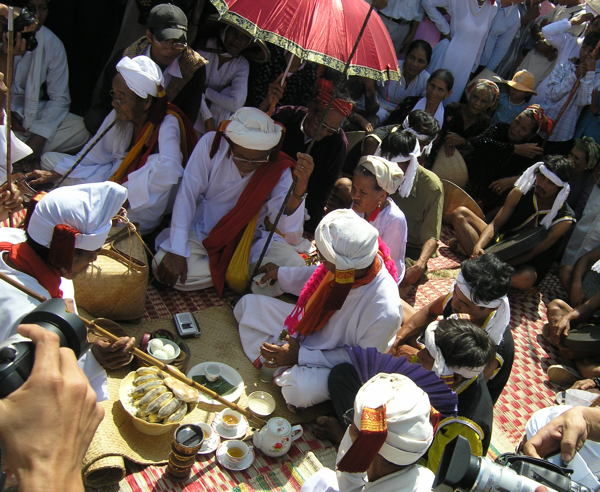
Trung.Bo-Phan.Rang-Fig3.jpg
The respite was brief, and shortly we were on the way back to the village temple with the palanquin that presumably contained the ritual items.
The next morning, I went to the larger of the two temple complexes, Po Klaung Gerai, which is situated on a hill near the center of Phan Rang city. The long lines of visitors wending their way up the hill made it clear that this was much more than a minority affair. I made my way up the trail with everyone else, and managed to work my way over to the terrace of the main temple. Any concerns I might have had about coming unannounced were immediately dispelled. Seeing a westerner with a camera, several men made a passage for me and propelled me to the front of the crowd clustered around the temple entrance. Not too many foreigners make it to the festival, and they were happy to get me closer to the story.
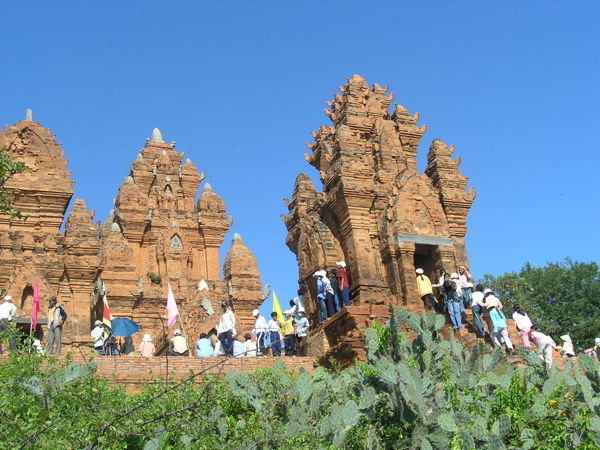
Festival-goers mount the steps to the gateway of the Po Klaung Gerai temple
However, as Gabrielle Vassal intimated in her comments on the Po Nagar temple, there is not much you can see from the outside of the temple. Ritual observances are usually quite public in Vietnam—especially in modern Vietnam—but it seemed fitting that the Cham ceremonies should be conducted in the privacy of the small temple chamber. On the other hand, it occurred to me that my anthropologist friend, who had made many friends among the Cham, might be observing the whole thing inside the chamber itself.
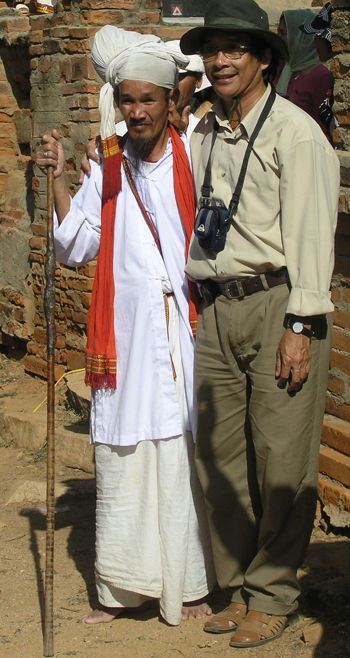
The most detailed account of the rituals that I have found is in an English translation of an article by Sakaya, a Cham scholar who is also known by the Vietnamese name Trương Văn Món.
According to Sakaya, the ceremonial day begins with a procession of the palanquin from the village temple to the tower, followed by a ritual dance performance with musical accompaniment. The high priest (Po Dhia) and the temple guardian perform a service to ask Siva for permission to open the door to the temple.
A musician plays on the rabab while the priestess (Muk Payau) approaches the entrance, sits beside the statue of the sacred bull Nandin, and sings a hymn. The door is then opened and the officiants enter the chamber.
While another hymn is sung, the temple guardian pours holy water over the head of the statue, and the others help rub the statue with their hands. Once cleaned, the statue is dressed with a skirt, tunic, scarf, belt, shoes, and cap.
The great ceremony then begins: the priestess presents the offerings as the musician plays the rabab and sings hymns to invite and praise each spirit. Over twenty spirits are worshipped in this ceremony, among them the goddess Po Nagar, the semi-legendary kings Po Klaung Gerai and Po Ro Me, and the minister Po Par. The ceremony closes with the priestess’s sacred dance.
Outside, the popular celebration continues, and everyone returns to the village to participate in community events such as the weaving competition in Mỹ Nghiệp village and water-carrying races (in which women balance jars on their heads). The singing and dancing carries on well into the night.
While at Po Klaung Gerai, I was able to reach the anthropologist by cell phone. She was at the other major temple, Po Ro Me, and recommended that I go there.
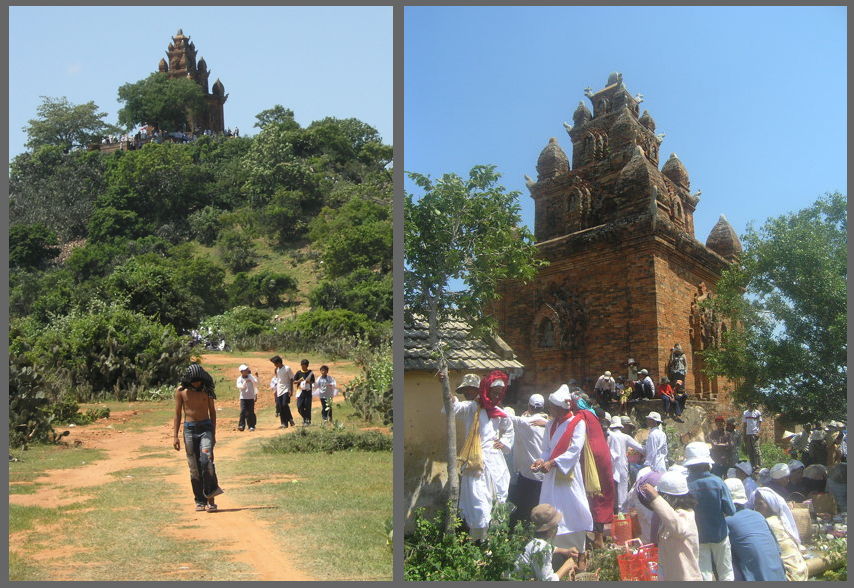
Po Ro Me is sometimes dismissed as a product of a culture in decline, but I’ve developed a deep affection for it. Part of it is the setting—before they put the road in, you had to walk a half-mile through the chapparal terrain to get to it. Even with the road, there is a short walk that gives you a chance to acclimate. As it stands now, it has but one tower, but its complex roof is elegantly articulated. From a distance, it does appear as a tree upon a hill.
It occurred to me that this might be the preferred destination for the Cham of Ninh Thuận; the big state-sponsored festival over at Po Klaung Gerai, with all its pomp and circumstance, was perhaps a decoy. There were no signs and banners at Po Ro Me, no throngs of tour groups. Instead, the tower was surrounded by families out for a picnic.
Of course, if I’d had a better plan, I’d have been on hand for the ritual opening of the temple, but I didn’t wallow in regret. It seemed like a fine day overall, and so it remained.
The Cham Pottery Village of Bàu Trúc
Before leaving Phan Rang, I have made it a habit to pay a visit to the Cham pottery village Bàu Trúc. And it is impossible for me to leave without a rich haul of its treasures, from replicas of the Cham towers and of their statues, to ingenious modern creations. Price is not an obstacle; the greatest challenge is finding a way to fit the booty into my luggage.
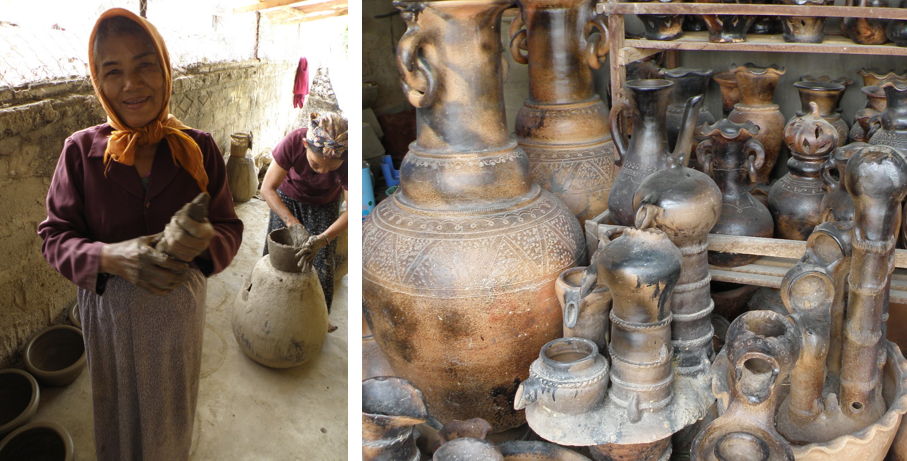
Bàu Trúc potter and her hoard. Below: Potters do not live by clay alone.
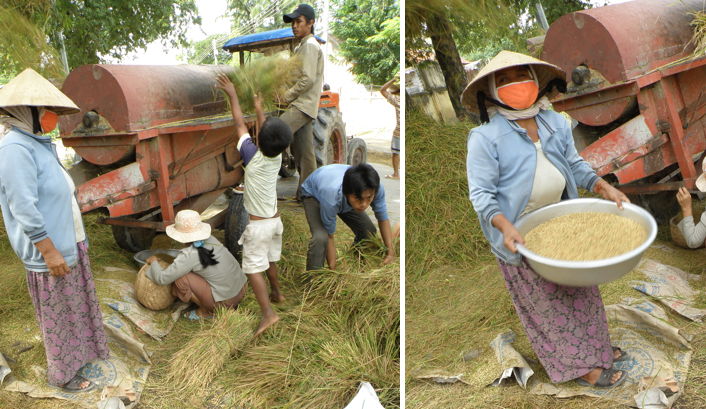
The village artisans seem to do very well by this trade and proudly display pictures of their trips to exhibitions as far away as Japan. The foreign recognition of the Cham artisans had been matched by Vietnamese news media, which runs occasional pieces on the village, touting it as “one of the two oldest pottery villages in Southeast Asia.”
Such attention might be dismissed as no more than promotional, but they represent a heartening change in attitude compared to the isolation and official marginalization of the Cham minority in previous decades.
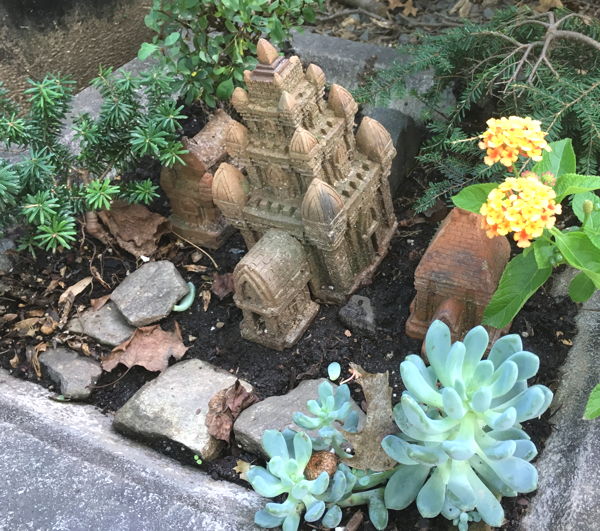
My own backyard recreation of a Cham temple complex, with three clay towers from Bàu Trúc village. The lantana flower (left) is frequently found at Cham sites.
The Sad Fate of the Hòa Lai towers
In contrast, Phan Rang also has a group of towers known as Hòa Lai, which have been long abandoned. The Cham of Ninh Thuận consider them to be alien, in some way “Khmer.” A few years ago, the provincial government had these ruined towers “restored,” adding modern bas-reliefs to simulate those that had disappeared. This amateurish effort rendered the architectural vestiges into a tidy confection that has no more historical relevance than Sleeping Beauty's Castle at Disneyland.
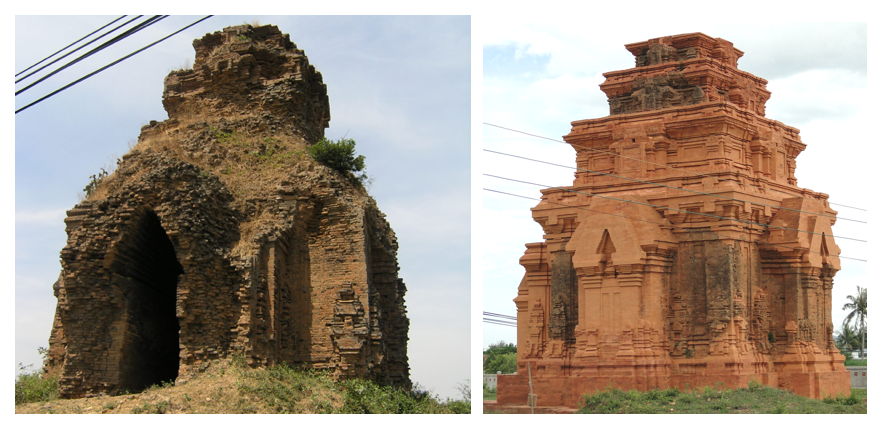
The original towers (2004) were admittedly in ruins, but the total buildover undertaken several years later has completely effaced the original.
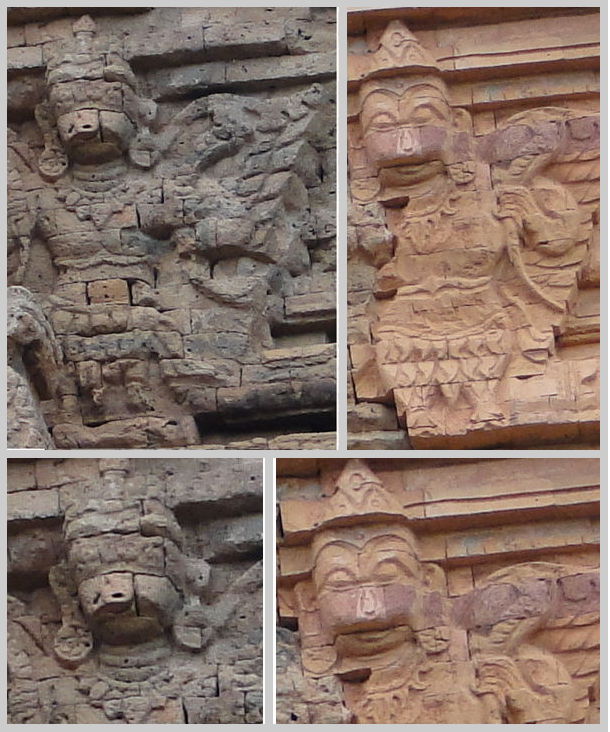
Some of the new carvings are imperfect attempts to approximate the original figures; others (below) are simply modern confections, with no connection to the original towers.
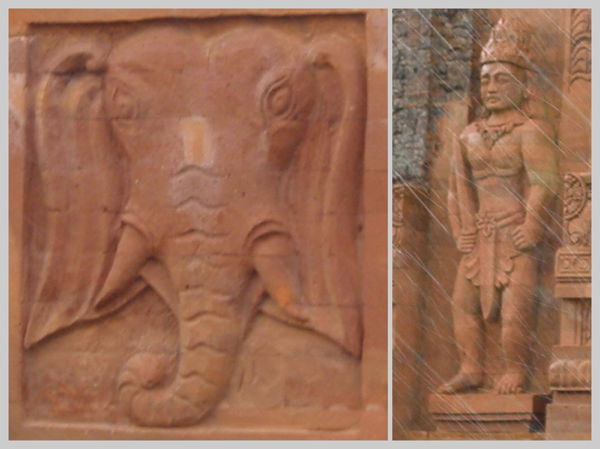
Some of the Cham specialists had tried to discourage the authorities, but to no avail. One of them asked me if I would write an article about the debacle—perhaps the words of a foreigner would be accepted where others were ignored, and perhaps it might establish some plausible arguments against future projects of this kind.
I did write the article, carefully modulating it (I thought) to avoid sounding too critical. However, it was no use. The accepted norm is to celebrate the proliferation of government-sponsored tourist sites, without raising troubling questions about historical or cultural preservation. An added incentive for local officials is the “surplus value” of all construction projects, which is readily tapped for both official and personal gain.
It is not only Cham artifacts that are threatened—the old temple to Bà Triệu in Thanh Hóa province, and the temple to An Dương Vương in Nghệ An province have been converted into hideous gray monoliths that have been erected on a standard plan.
- Les Tchames et Leur Religions (1891), by Etienne Aymonier, translated by Walter E.J. Tips as The Chams and their Religions, and published in a volume entitled Cham Sculptures-Religious Ceremonies and Superstitions of Champa, White Lotus Press, Bangkok, Thailand, 2001. Aymonier was one of the first French researchers to explore the region of Champa. His interest was anthropological, and so this work is valuable for its recording of customs and folklore. White Lotus Press edition also includes The Religious ceremonies and superstitions of Champa by Paul Mus (from BEFEO, Volume XXIII) and Cham Sculpture of the Tourane Museum by Henri Parmentier (1922).
- “Textes chinoises sur Panduranga,” Louis Finot, BEFEO 1903.
- “Tchen-la et Panduranga,” Pierre Dupont, BSEI, 1949.
- Les Portugais sur les côtes du Viêt-Nam et du Campa: étude sur les routes maritimes et les relations commerciales, d'après les sources portugaises : XVIe, XVIIe, XVIIIe siècles, Pierre-Yves Manguin, École française d'Extrême-Orient, 1972.
- “The Cham Presence in the Highlands,” in Sons of the Mountains, Gerald Cannon Hickey, Yale University Press, 1982.
- Le Panduranga (Campa) 1802-1835, ses rapports avec le Vietnam, Po Dharma, École Français d’Extrême Orient, Paris, 1987.
- “The Coming of Islam to Champa,” Rie Nakamura, Journal of the Malaysian Branch of the Royal Asiatic Society, Vol. 73, No. 1 (278) (2000).
- “Cham Temple Festivals,” Sakaya, Vietnamese Studies, No3-2003, published in Hà Nội.
- “The Cham's First Highland Sovereign: Po Romé (r. 1627-1651),” William Noseworthy, Asian Highlands Perspectives 28, 2013.
- “Shifting the Nationalist Narrative? Representing Cham and Champa in Vietnam’s Museums and Heritage Sites,” Rie Nakamura*, Claire Sutherland, Museum & Society, 17(1), March 2019.
- A Journey of Ethnicity: In Search of the Cham of Vietnam, Rie Nakamura, Cambridge Scholars Publishing, 2020.
